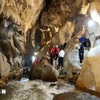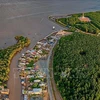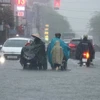Hanoi (VNA) – Vietnam is home to 53 ethnic minority groups with a population of nearly 14 million, who mainly live in remote mountainous, midland and coastal areas that are vulnerable to natural disasters.
Vietnam is one of the five countries most affected by climate change – especially rising sea levels. Each year, the country is hit by between five to seven storms and floods, which seriously impact 50 percent of land and 70 percent of the population.
Ethnic minority groups in particular have become more aware of climate change, which has increased the frequency and severity of droughts, floods and landslides in recent years.
Landslides triggered by heavy rains in the northern mountainous provinces of Son La, Lao Cai and Yen Bai, as well as the Central Highlands, have spoilt farmland. Prolonged drought in the central province of Ninh Thuan has brought about water shortages.
In the Central Highlands, water reservoirs, rivers and streams as well as underground water resource are running out of water. The area of primeval forest has also shrunk, causing a loss of biodiversity.
Ethnic minorities have been proactively mitigating the impacts of environmental changes, but it has been difficult to sustain the outcomes of their efforts.
To that end, it is necessary for the State to spread relevant information in ethnic minority languages and consult indigenous people when planning to build infrastructure such as hydropower plants and transport systems in their areas.
Financial resources are needed to address the consequences of natural disasters in ethnic minority-inhabited areas.
The State should design policies to stabilise local livelihoods and reduce the number of nomadic farmers.
Enhancing the resilience capacity of ethnic minorities is essential for coping with climate change and and creating sustainable production. Forest protection is considered an effective solution.
It is crucial to raise ethnic groups’ awareness of State policies and regulations on forest and biodiversity protection, climate change and sustainable forest management.
The State needs to prevent indiscriminate exploitation of natural resources such as gold, sand, wood and ore; encourage households to increase investment in animal husbandry; support the protection of natural forest areas; and rehabilitate degraded land.
Relocating households in flood- and landslide-prone areas to safer places and creating more occupational opportunities to increase local incomes are strongly suggested.-VNA























